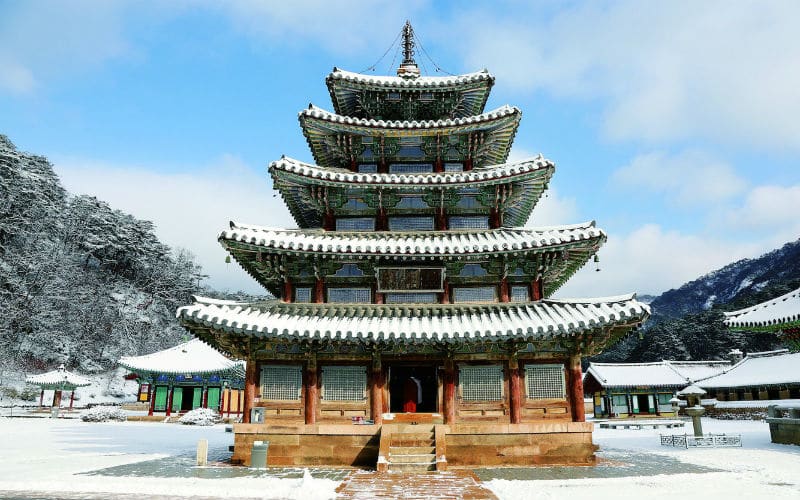These gorgeous locations are officially protected so the future generation can enjoy them.


The United Nations Educational, Scientific and Cultural Organization has been preserving landmarks around the world for more over 50 years. UNESCO continues to choose special locations all over the globe that must be shared with future generations. The organization has added 19 new World Heritage Sites to the growing list and the latest additions are truly stunning.
What makes these new landmarks so special? World Heritage Sites are chosen for their cultural, historical, and physical significance. Here are the 19 stunning new locations that are now destined to mesmerize more people in the future.


The seven temples that make up this new World Heritage Site were built between the 7th and 9th century. Although the location regularly plays host to hundreds of tourists, the Sansa is still an ideal place for daily religious practice.
The Amazon park is home to over 75,000 paintings that decorate the walls in several rock shelters. The location is aptly dubbed, “The Maloca of the Jaguar” and is known for its table-top mountains.
The former seat of the Caliphate of Cordoba was built during the 10th century but was almost destroyed in a civil war. The city was forgotten for hundreds of years. However, it was rediscovered in the early 20th century.
Kyushu Island has ten villages that was home to Christian missionaries and settlers in Japan. The island also has the Hara Castle as well as a cathedral that was built between the 16th and 19th centuries. It is a reminder of the times when Christian faith was prohibited in Japan.
The Inuit hunting grounds is a gorgeous landscape that takes pride in its long history. The hunting ground offers a glimpse at a culture that has survived for over 42,000 years.
The stunning cathedral was built in 1028 and is a perfect example of how Romanesque structure began adopting Gothic architecture. The Naumburg Cathedral was one of the first new World Heritage Sites announced by UNESCO earlier this year.
The site is known for its magnificent structures built by ancient hunters during the Pre-Pottery Neolithic age between 9,600 and 8,200 BC.
The site is home to some of the world’s oldest geological structures dating back 3.6 to 3.25 billion years.
UNESCO chose the site because it featured evidence of how ancient humans used technological developments like canals and aqueducts as they began domesticating crops.
The property known as the Limagne fault tectonic arena is a direct result of the formation of the Alps almost 35 million years ago.
Back in the day, Hedeby was a major trading post that welcomed merchants from continental Europe and Scandinavia. The site offers a glimpse to how Europe thrived during the Viking Age.
The largest oasis in the world is also a testament to how man adapted to his surroundings and somehow conquered the desert.
The forest known as “The Land That Gives Life” is home to an indigenous people called the Anishinaabeg. The communities continue to live in the forest and take special care to remain in harmony with the land.
The city of Ivrea is an obvious choice for UNESCO due to its interesting architecture. The city brings architecture and industrial advancement together with stunning results.
A collection of eight archaeological sites located in Firuzabad, Bishapur and Sarvestan of the Fars Region are now World Heritage Sites. The landscape includes palaces and fortified structures that may have been around since 658 CE.
Mumbai’s ascent as a global trading center has resulted in an amazing collection of buildings in the Victorian Neo-Gothic style as well as the Art Deco idiom. Not surprisingly, UNESCO chose to protect these impressive ensembles for future generations.
The well-preserved wall settlement called Thimlich Ohinga was built in the 16th century CE. Additionally, it may have protected livestock and communities for several years.
The site once served the Hormuz princes during the 11th and 15th centuries CE. Today, it is proof that merchants from East Africa, India, China, and Southeast Asia traded in the east coast of Arabia.
Table of Contents: Introduction: The Significance of the March 14th Holiday The Mathematical Marvel: Unraveling…
Who made them disappear? What was the reason? Where did they go? Why? Gather round,…
Swarm of bees stings the eyes of penguins in Cape town 60 penguins died from…
A massive ocean sunfish measuring 2,000 kilograms was caught on North African Coast It is named Mola alexandrini or…
A businessman in Georgia utilized the Covid-19 relief to buy a limited edition Charizard Pokemon card He committed…
Man captures an alligator in his neighbor's yard in FloridaHe uses a trash can to…
This website uses cookies to ensure you get the best experience.
Leave a Comment